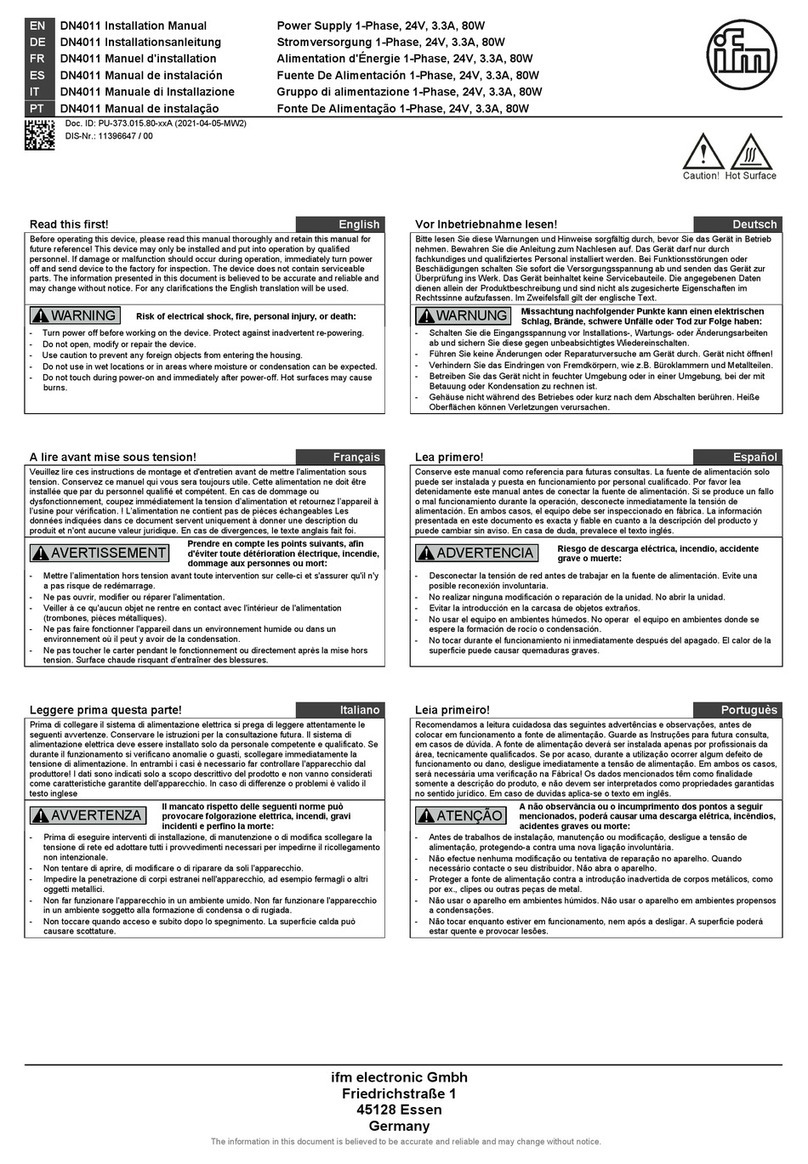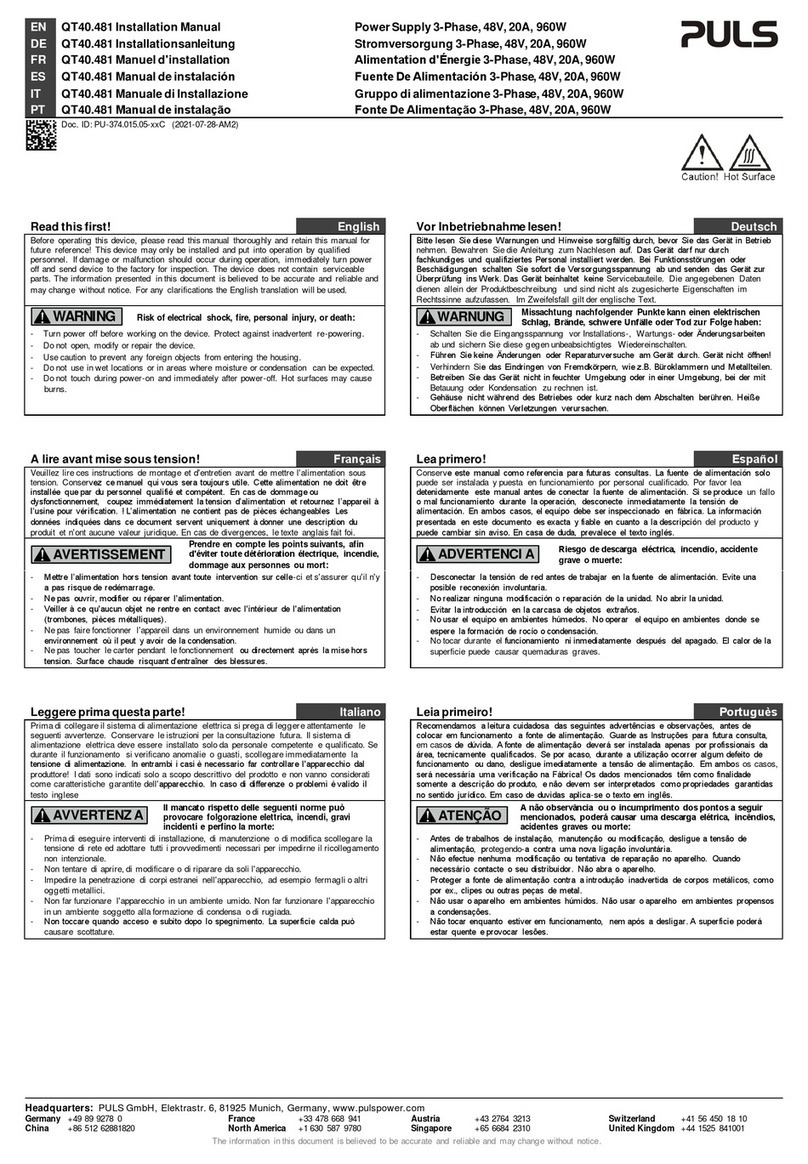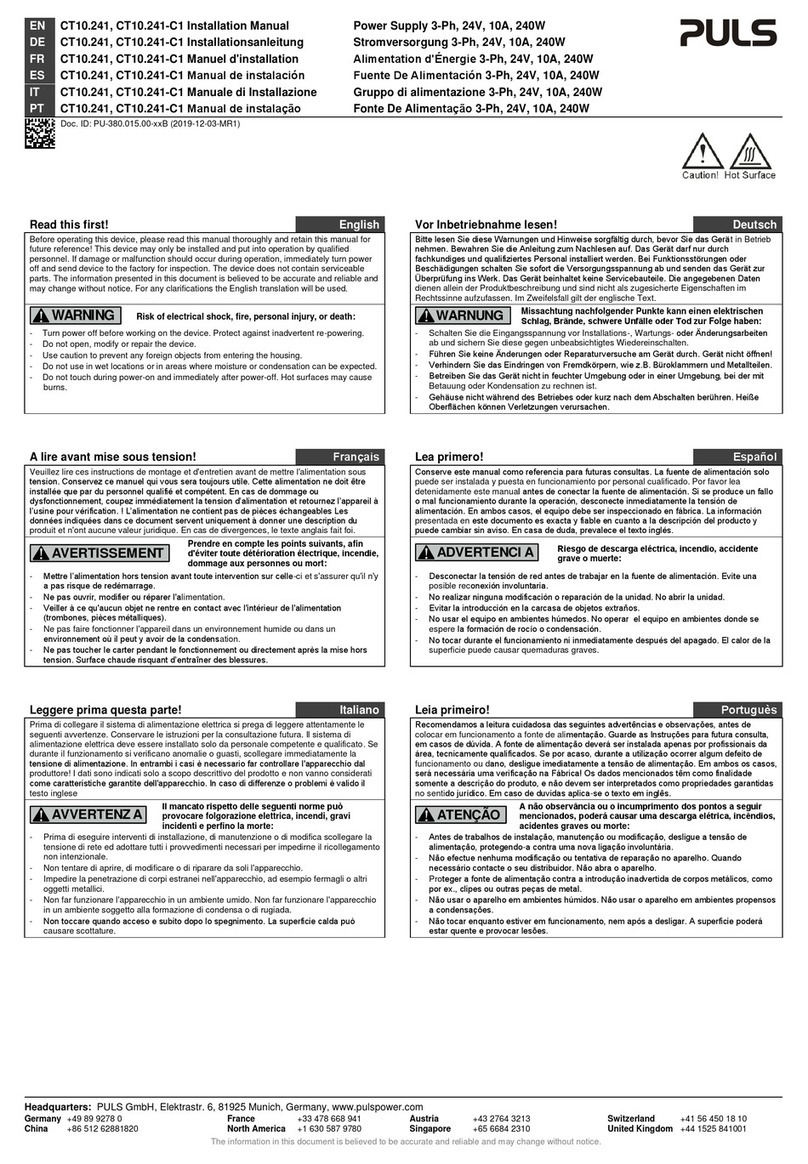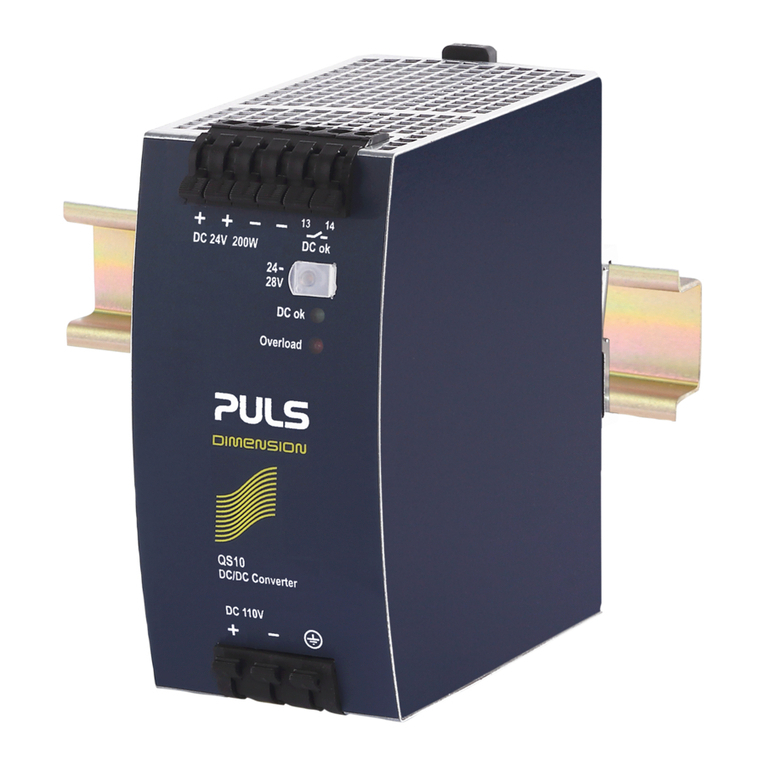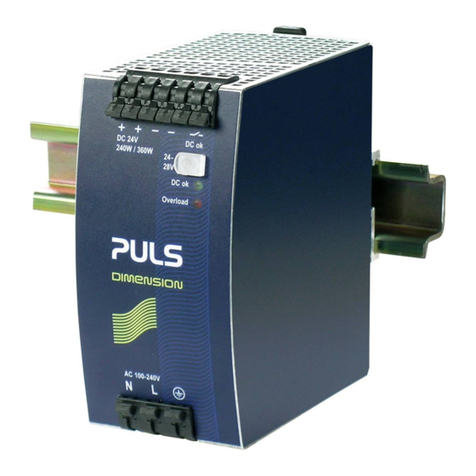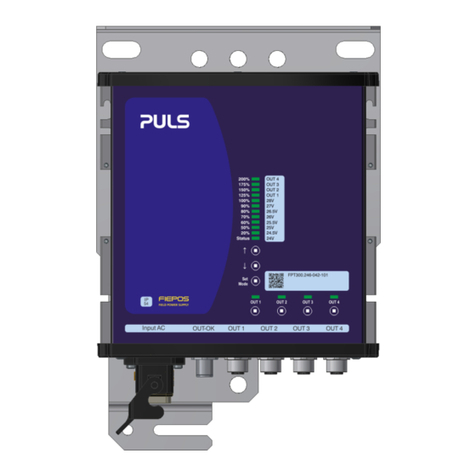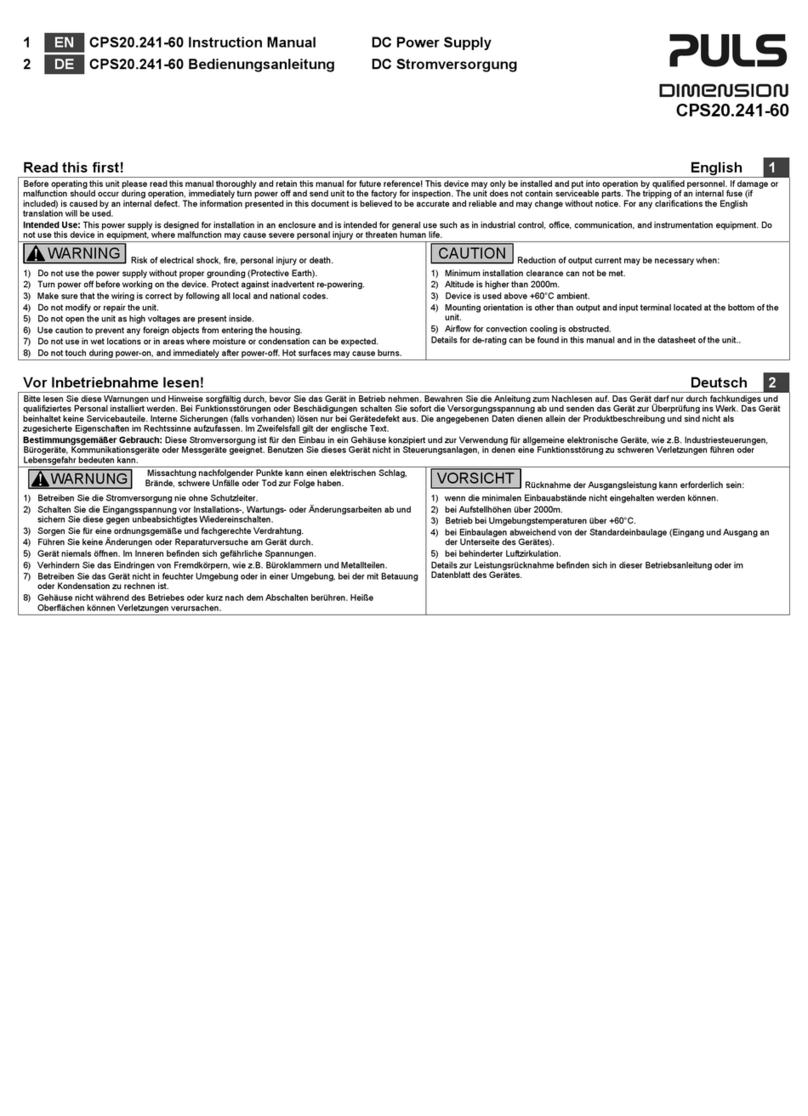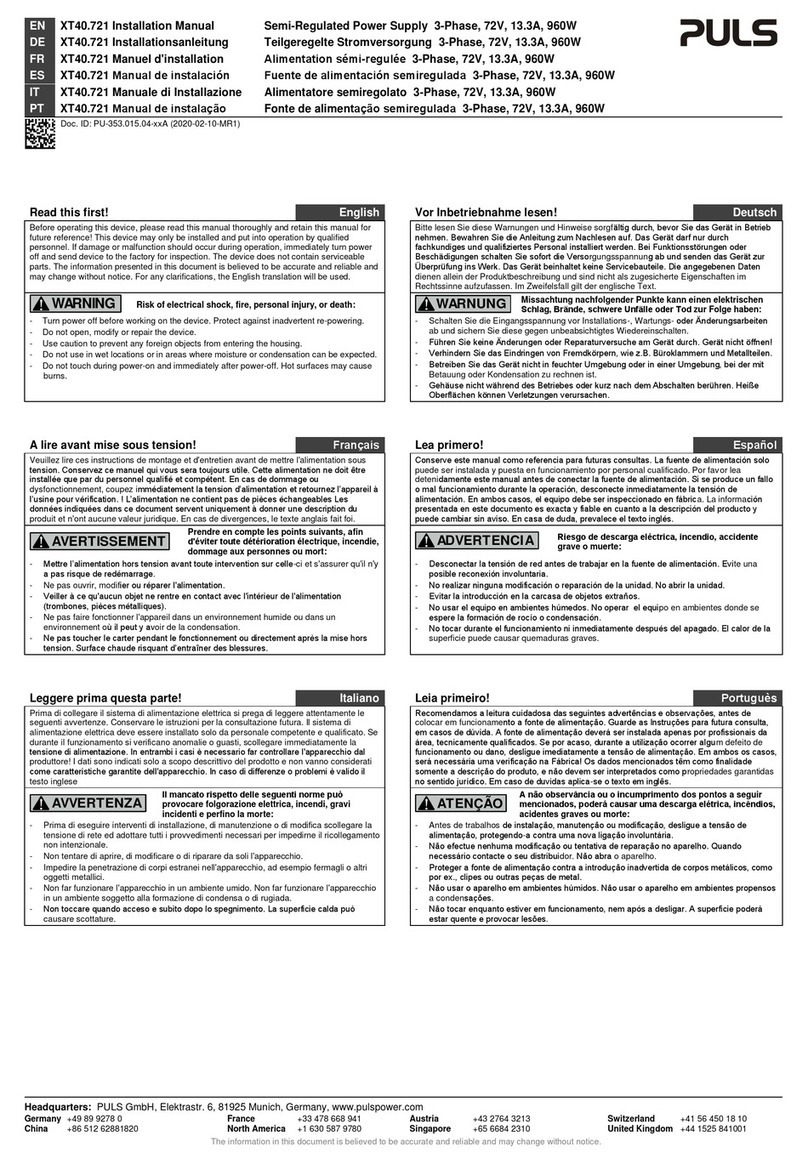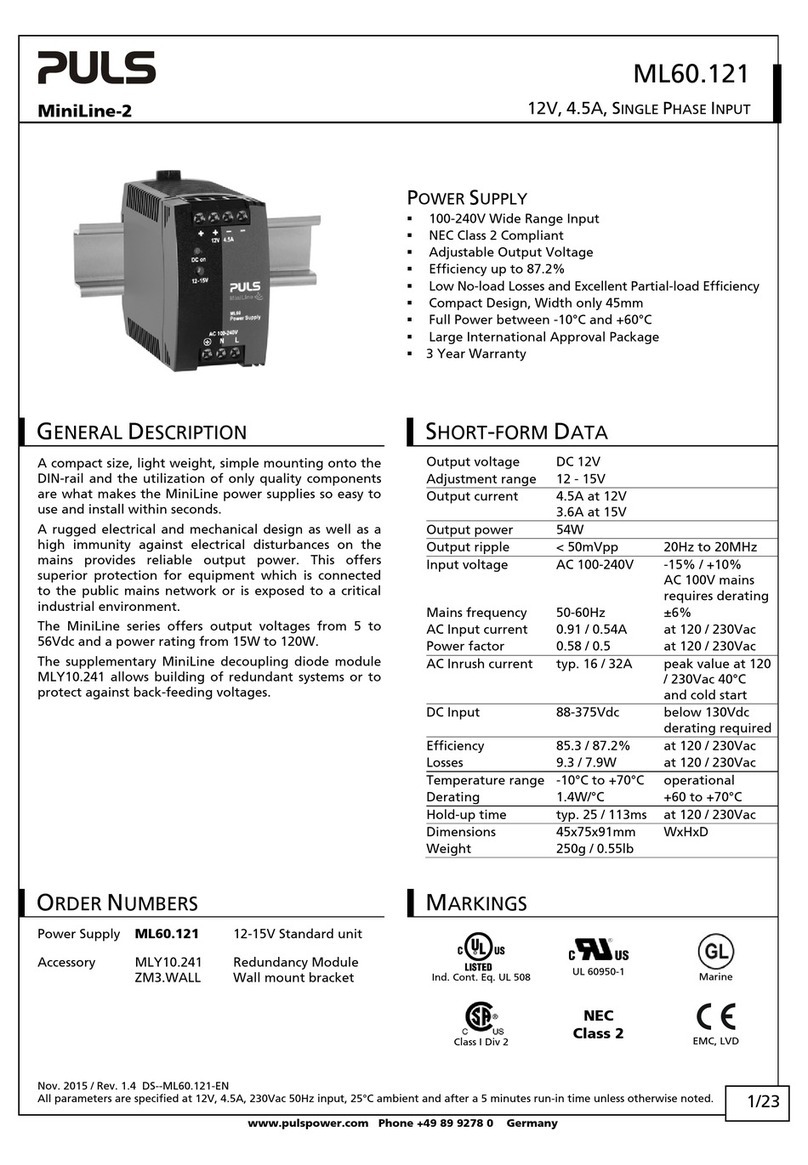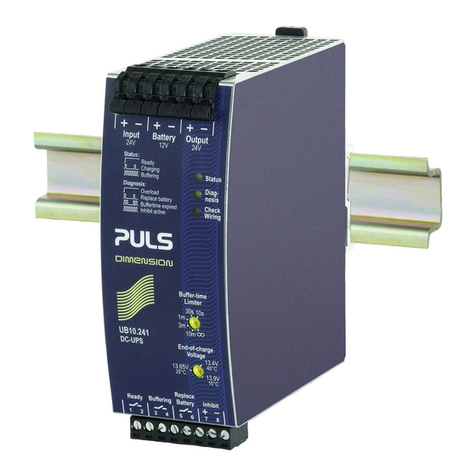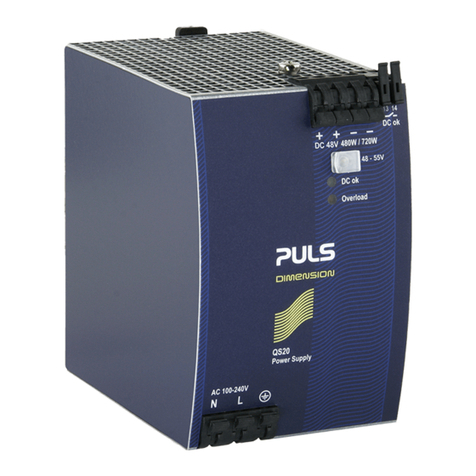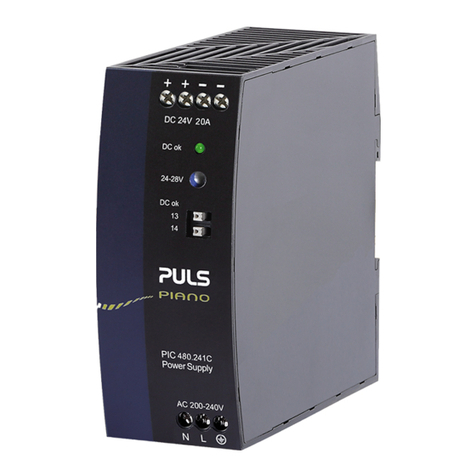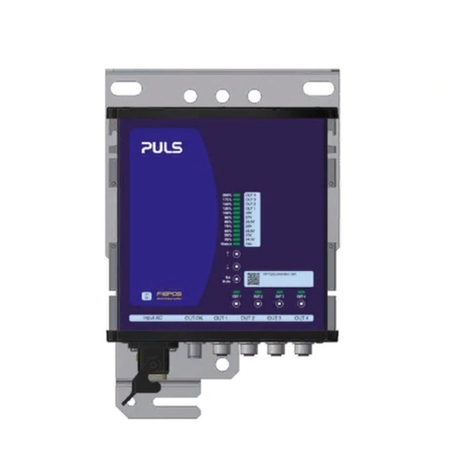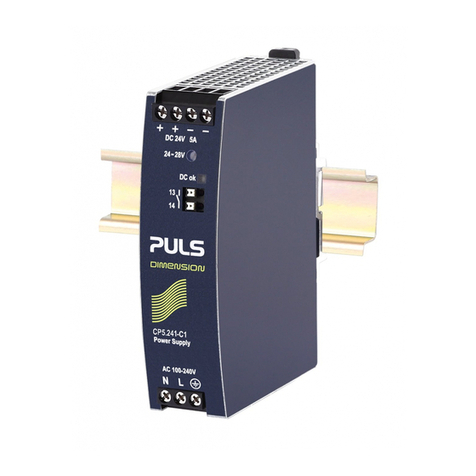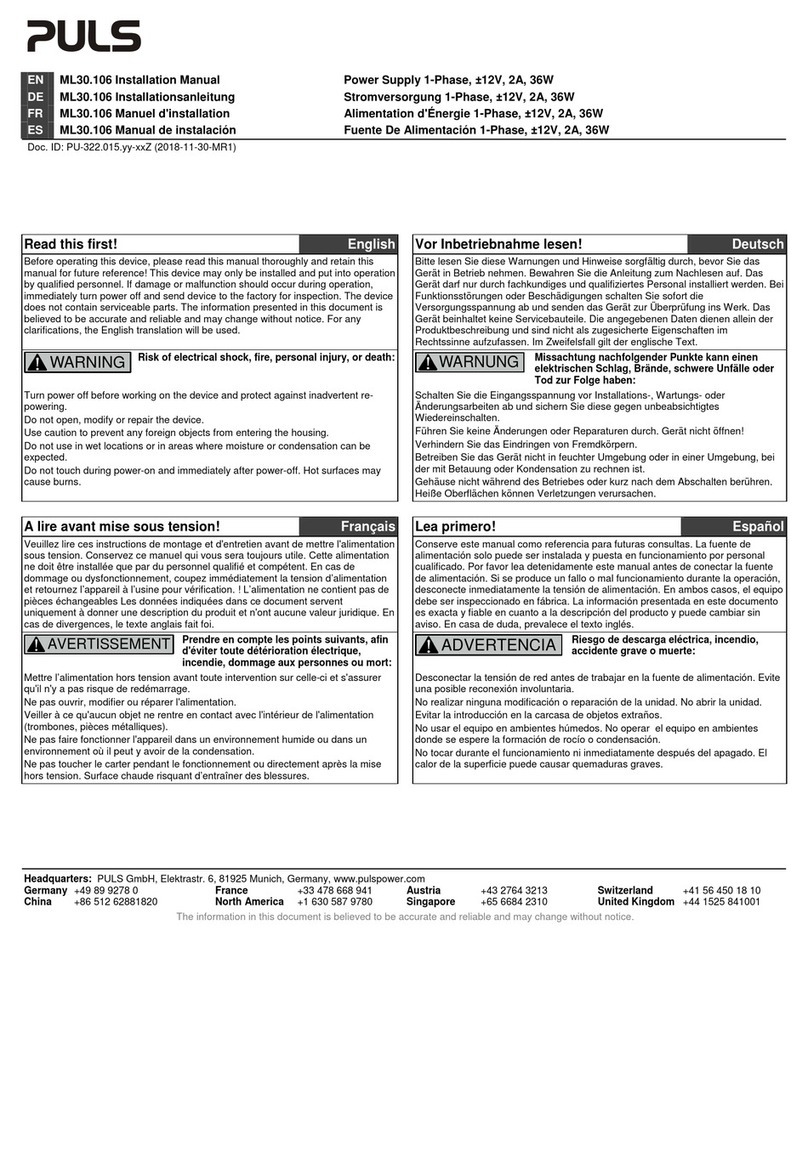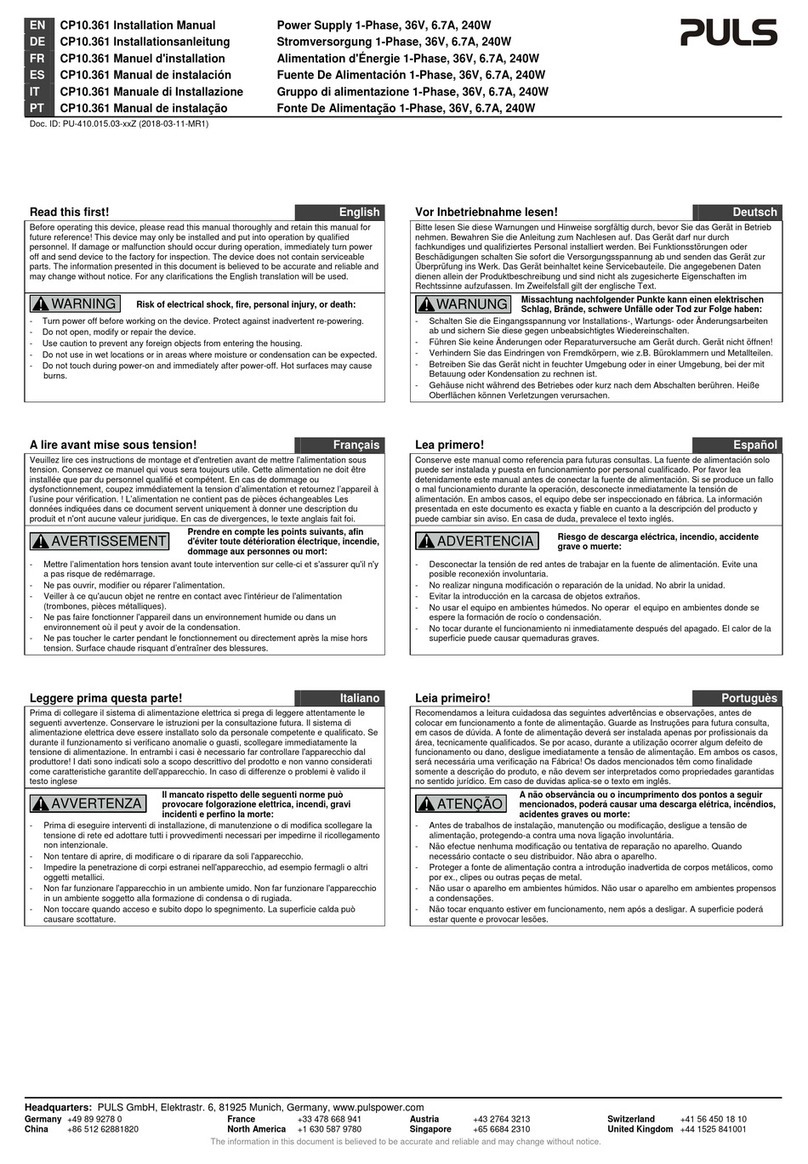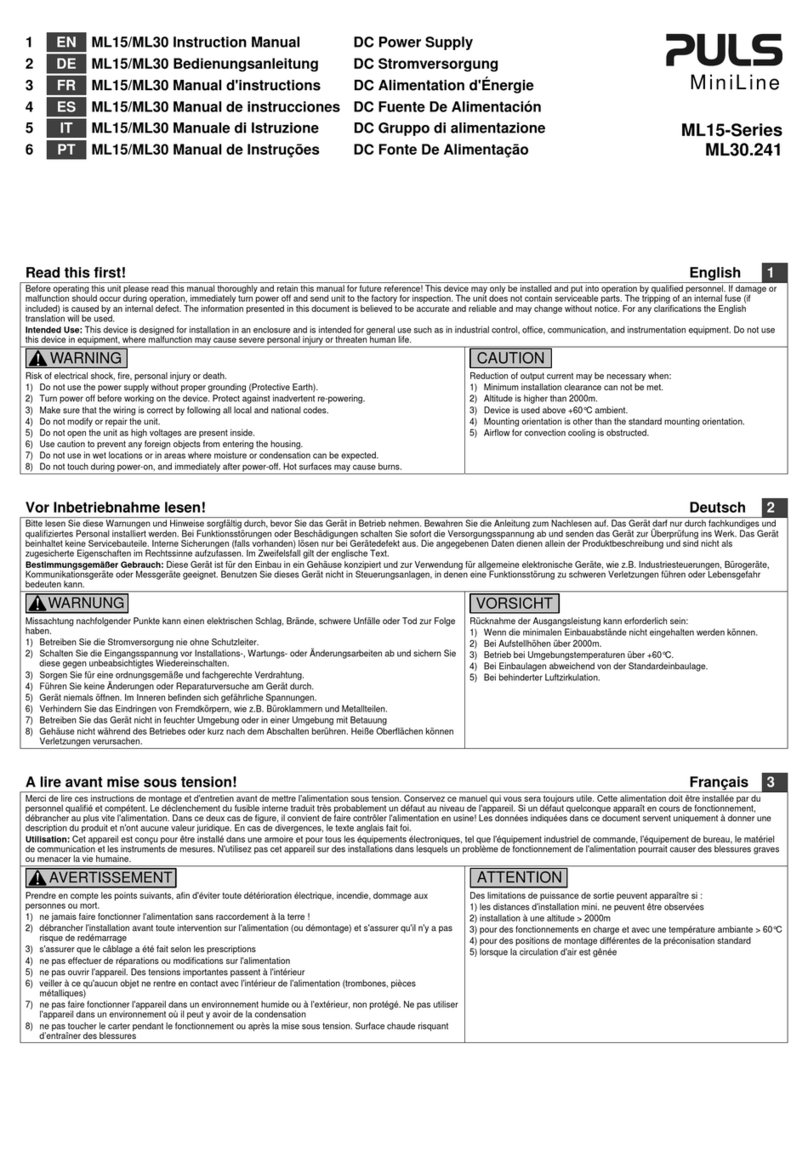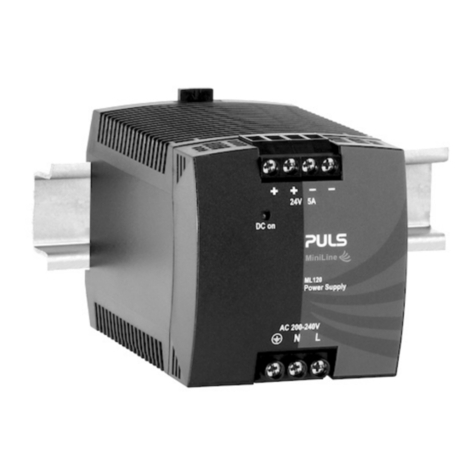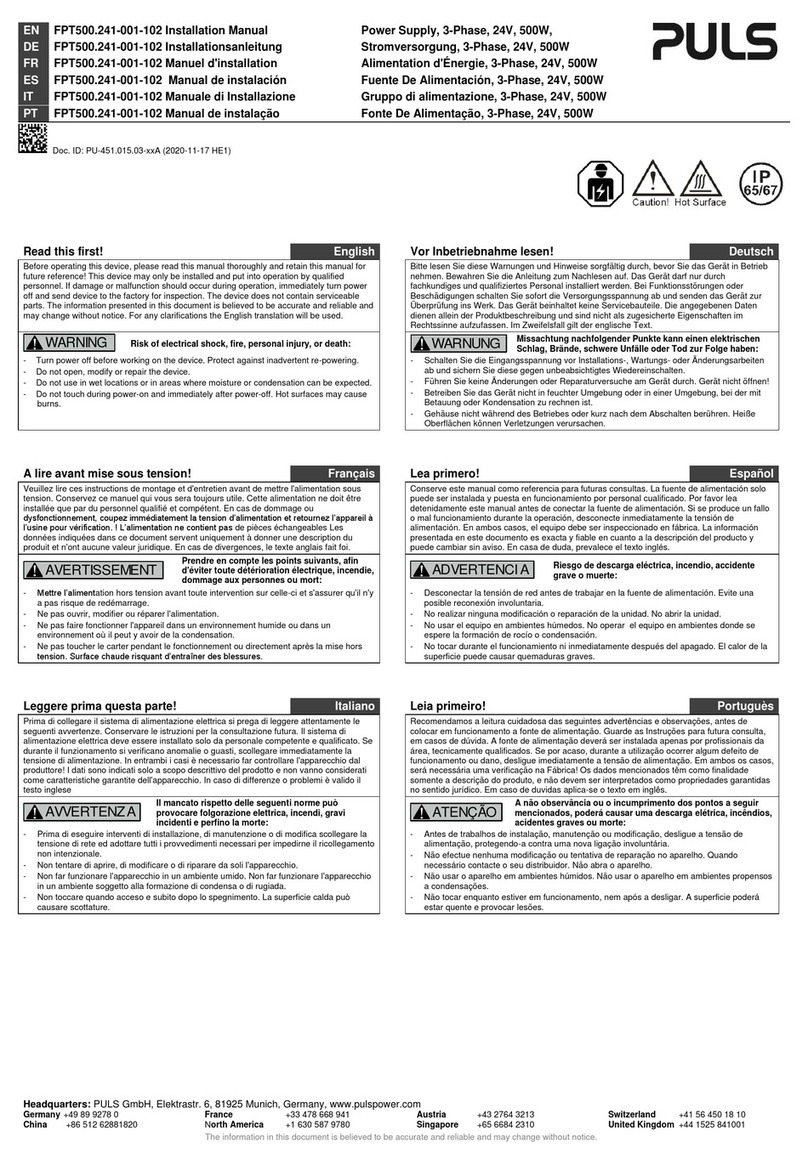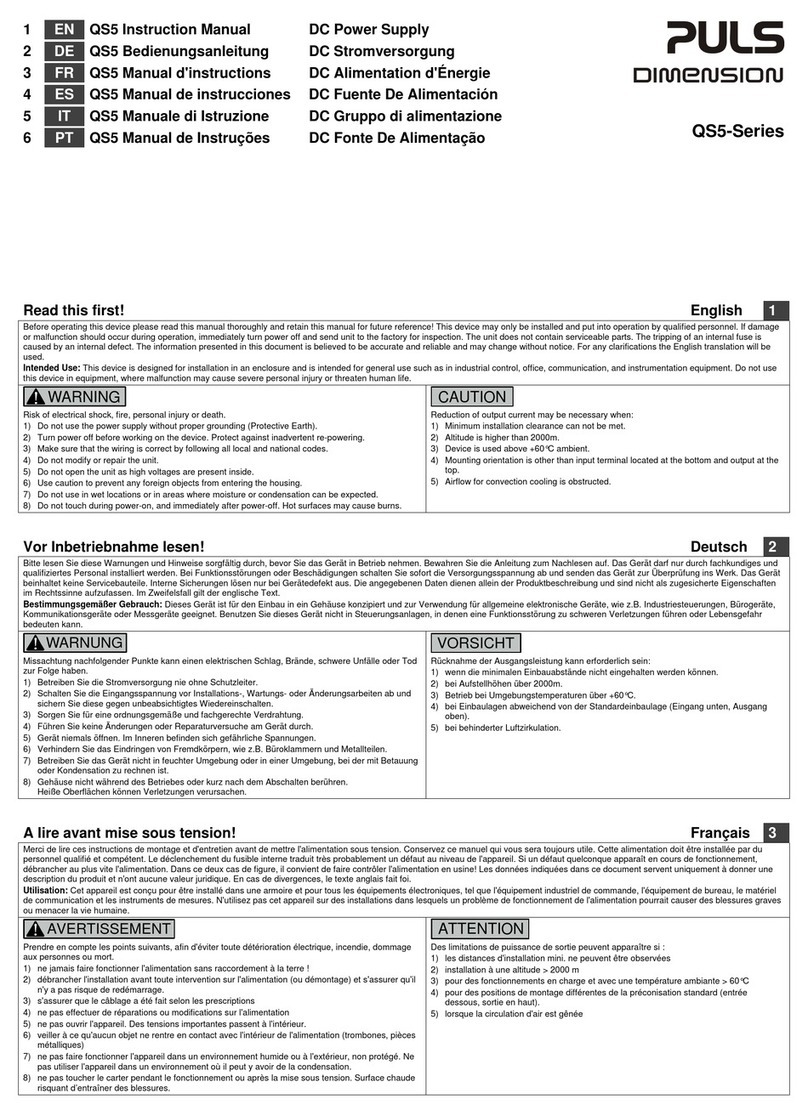
Lea primero! Español 4
Conserve este manual como referencia para futuras consultas. La fuente de alimentación solo puede ser instalada y puesta en funcionamiento por personal cualificado. Por favor lea detenidamente
este manual antes de conectar la fuente de alimentación.
Uso apropiado:
Este equipo ha sido diseñado para su instalación en un ambiente cerrado y ha sido concebido para uso general en instalaciones de control industrial, oficinas, comunicaciones y equipos de
instrumentación. No emplee este equipo en aeronaves, trenes e instalaciones atómicas, donde un mal funcionamiento de la fuente de alimentación puede ocasionar lesiones graves o riesgo mortal.
ADVERTENCIA ! CUIDADO !
Riesgo de descarga eléctrica, incendio, accidente grave o muerte.
(1) No conectar nunca la unidad sin conexión de puesta a tierra.
(2) Desconectar la tensión de red antes de trabajar en la fuente de alimentación. Evite una
posible reconexión involuntaria.
(3) Asegurarse de que el cableado es correcto de acuerdo a los códigos locales y
nacionales.
(4) No realizar ninguna modificación o reparación de la unidad.
(5) No abrir nunca la unidad. En el interior existe riesgo de altas tensiones.
(6) Evitar la introducción en la carcasa de objetos extraños.
(7) No usar el equipo en ambientes húmedos.
(8) No operar el equipo en ambientes donde se espere la formación de rocío o
condensación.
La deriva en la tensión de salida se produce:
(1) cuando no pueden mantenerse las distancias mínimas de montaje.
(2) en caso de que el montaje se realice en altitudes superiores a los 2000 m.
(3) en caso de funcionamiento a plena carga y temperaturas ambientales superiores a 60º C.
(4) En caso de posiciones de montaje diferentes a la posición de montaje estándar (terminales de
entrada abajo y terminales de salida arriba).
(5) en caso de que la circulación de aire para la refrigeración por conducción esté obstruida.
Puede encontrar más detalles del caso de deriva en este manual.
No tocar durante el funcionamiento ni inmediatamente después del apagado. El calor de la superficie
puede causar quemaduras graves.
Cuando se funde un fusible interno, existe gran probabilidad de un fallo interno en el equipo.Si se
produce un fallo o mal funcionamiento durante la operación, desconecte inmediatamente la tensión
de alimentación. En ambos casos, el equipo debe ser inspeccionado en fábrica.
La información presentada en este documento es exacta y fiable en cuanto a la descripción del producto y puede cambiar sin aviso. En casa de duda, prevalece el texto inglés.
Uso apropiado
Class I Div 2
ATENCIÓN PELIGRO DE EXPLOSIÓN! Los equipos marcados con la expresión "Class I Div 2" son adecuados para su uso en ambientes no peligrosos y en entornos con
la Clase I División 2 Grupos A, B, C, D. La sustitución de componentes puede perjudicar la idoneidad para la Clase I División 2.
No desconecte el equipo a menos que la tensión de alimentación esté desconectada.
El conexionado debe cumplir con la Clase I División 2 métodos de conexión del Código Nacional Eléctrico NFPA 70 o con el resto de códigos locales o nacionales.
Leggere prima questa parte! Italiano 5
Prima di collegare il sistema di alimentazione elettrica si prega di leggere attentamente le seguenti avvertenze. Conservare le istruzioni per la consultazione futura. Il sistema di alimentazione elettrica
deve essere installato solo da personale competente e qualificato.
Uso previsto:
Questo apparecchio è previsto per il montaggio in un rack per moduli elettronici, ad esempio per controllori industriali, apparecchiature per ufficio, unità di comunicazione o apparecchi di misura. Non
utilizzare l'apparecchio in impianti di controllo di aerei, di treni o di impianti nucleari in cui il suo eventuale guasto può comportare gravi lesioni o la morte di persone.
AVVERTENZA! CAUTELA !
Il mancato rispetto delle seguenti norme può provocare folgorazione elettrica, incendi, gravi
incidenti e perfino la morte.
(1) Non far funzionare in nessun caso il sistema di alimentazione elettrica senza conduttore di
protezione!
(2) Prima di eseguire interventi di installazione, di manutenzione o di modifica scollegare la
tensione di rete ed adottare tutti i provvedimenti necessari per impedirne il ricollegamento
non intenzionale.
(3) Assicurare un cablaggio regolare e corretto.
(4) Non tentare di modificare o di riparare da soli l'apparecchio.
(5) Non aprire l'apparecchio. Al suo interno sono applicate tensioni elettriche pericolose.
(6) Impedire la penetrazione di corpi estranei nell'apparecchio, ad esempio fermagli o altri
oggetti metallici.
(7) Non far funzionare l'apparecchio in un ambiente umido.
(8) Non far funzionare l'apparecchio in un ambiente soggetto alla formazione di condensa o
di rugiada.
È necessario ridurre la potenza di uscita se:
(1) non è possibile rispettare le distanze minime di montaggio;
(2) l'apparecchio viene installato in un luogo di altitudine maggiore di 2000 m;
(3) il funzionamento è a pieno carico a temperatura ambiente maggiore di 60 °C;
(4) la posizione di montaggio differisce da quella standard (ingresso in basso, uscita in alto);
(5) è ostacolata la libera circolazione dell'aria.
Ulteriori informazioni sono riportate in questo manuale.
Non toccare quando acceso e subito dopo lo spegnimento. La superficie calda può causare
scottature.
In caso di intervento del fusibile interno, molto probabilmente l'apparecchio è guasto.
Se durante il funzionamento si verificano anomalie o guasti, scollegare immediatamente la tensione di
alimentazione.
In entrambi i casi è necessario far controllare l'apparecchio dal produttore!
I dati sono indicati solo a scopo descrittivo del prodotto e non vanno considerati come caratteristiche garantite dell'apparecchio.In caso di differenze o problemi è valido il testo inglese
Uso previsto
Class I Div 2
ATTENZIONE: PERICOLO DI ESPLOSIONE! Gli apparecchi la cui targhetta riporta "Class I Div 2" sono adatti per l'impiego in ambienti di classe I, divisione 2, gruppi A, B,
C e D o non soggetti al pericolo di esplosione. La modifica dei componenti possono influenzare negativamente l'idoneità per ambienti di classe I, divisione 2.Non aprire i
morsetti con tensione di alimentazione collegata. Il collegamento deve essere eseguito nel rispetto dei requisiti previsti dalla classe I, divisione 2, articolo 501-4(b) del
National Electrical Code, NFPA 70.
Leia primeiro! Portuguès 6
Recomendamos a leitura cuidadosa das seguintes advertências e observações, antes de colocar em funcionamento a fonte de alimentação. Guarde as Instruções para futura consulta, em casos de
dúvida. A fonte de alimentação deverá ser instalada apenas por profissionais da área, tecnicamente qualificados.
Utilize:
apenas para o fim pré-estabelecido. Este aparelho foi concebido para ser montado dentro de invólucros, caixas ou armários para aparelhos eletrônicos em geral, como, por exemplo, comandos de
instalações industriais, aparelhos para escritórios, aparelhos de comunicação ou instrumentos de medida e quadros eléctricos. Não utilize este aparelho em sistemas de comando de aviões, de
comboios ou em instalações movidas por energia nuclear, nos quais um defeito de funcionamento poderá causar danos graves ou significar risco de morte.
ATENÇÃO ! CUIDADO !
A não observância ou o incumprimento dos pontos a seguir mencionados, poderá causar
uma descarga elétrica, incêndios, acidentes graves ou morte.
(1) Não use a fonte de alimentação sem o condutor de proteção terra!
(2) Antes de trabalhos de instalação, manutenção ou modificação, desligue a tensão de
alimentação, protegendo-a contra uma nova ligação involuntária.
(3) As ligações devem ser efectuadas apenas por profissionais competentes.
(4) Não efectue nenhuma modificação ou tentativa de reparação no aparelho. Quando
necessário contacte o seu distribuidor.
(5) Não abra o aparelho mesmo quando desligado. No seu interior existem condensadores
que podem estar carregados electricamente.
(6) Proteger a fonte de alimentação contra a introdução inadvertida de corpos metálicos,
como por ex., clipes ou outras peças de metal.
(7) Não usar o aparelho em ambientes húmidos.
(8) Não usar o aparelho em ambientes propensos a condensações.
Será necessário reduzir a potência de saída nos seguintes casos:
(1) Quando não forem observadas as distâncias mínimas de montagem.
(2) Quando instaladas a altitudes superiores a 2000m.
(3) Existencia de temperatura ambiente superior a 60ºC, em plena carga do aparelho.
(4) Montagem invertida do aparelho (Entrada em baixo, saída em cima).
(5) Montagem em ambiente sem ventilação.
No presente manual de funcionamento encontram-se ainda outras informações.
Não tocar enquanto estiver em funcionamento, nem após a desligar. A superficie poderá estar quente
e provocar lesões.
Se o fusível interno se fundir, é grande a possibilidade de existir um defeito no aparelho. Se por
acaso, durante a utilização ocorrer algum defeito de funcionamento ou dano, desligue imediatamente
a tensão de alimentação.
Em ambos os casos, será necessária uma verificação na Fábrica!
Os dados mencionados têm como finalidade somente a descrição do produto, e não devem ser interpretados como propriedades garantidas no sentido jurídico. Em caso de duvidas aplica-se o texto
em inglês.
Utilize
Class I Div 2
ATENÇÃO, RISCO DE EXPLOSÃO ! Aparelhos que contêm na sua placa de dados elétricos o texto “Class I Div 2” são apropriados para a aplicação na Classe I, divisão 2,
Grupos A, B, C, D ou também para locais de instalação isentos de riscos de explosão.
Modificações efetuadas em componentes podem restringir ou reduzir a adequação para aplicação na Classe I, Divisão 2. As ligações não devem ser separadas enquanto
estiverem ligadas a uma fonte de alimentação elétrica. As ligações devem ser efetuadas levando-se em consideração as exigências normativas da Classe I, Divisão 2.
Germany PULS in Munich +49 89 9278 0 www.pulspower.com
China PULS in Shanghai +86 21 6432 7680 www.puls-power.cn
France PULS in Limonest / Lyon +33 478 668 941 www.puls-power.com/fr
North America PULS in St. Charles / Chicago +1 630 587 9780 www.puls-power.us
Austria PULS in Rohrbach +43 27 64 32 13 www.pulspower.com
Switzerland PULS in Oberflachs / Aargau +41 56 450 18 10 www.puls-power.ch
United Kingdom PULS in Bedfordshire +44 845 130 1080 www.puls.co.uk
Headquarters:
PULS GmbH
Arabellastrasse 15
D-81925 Munich
Germany
